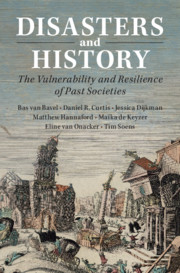Book contents
- Disasters and History
- Disasters and History
- Copyright page
- Contents
- Figures
- Tables
- Preface
- 1 Introduction: Disasters and History
- 2 Classifications and Concepts
- 3 History as a Laboratory: Materials and Methods
- 4 Disaster Preconditions and Pressures
- 5 Disaster Responses
- 6 Effects of Disasters
- 7 Past and Present
- References
- Index
Index
Published online by Cambridge University Press: 06 October 2020
- Disasters and History
- Disasters and History
- Copyright page
- Contents
- Figures
- Tables
- Preface
- 1 Introduction: Disasters and History
- 2 Classifications and Concepts
- 3 History as a Laboratory: Materials and Methods
- 4 Disaster Preconditions and Pressures
- 5 Disaster Responses
- 6 Effects of Disasters
- 7 Past and Present
- References
- Index
Summary
- Type
- Chapter
- Information
- Disasters and HistoryThe Vulnerability and Resilience of Past Societies, pp. 225 - 232Publisher: Cambridge University PressPrint publication year: 2020
- Creative Commons
- This content is Open Access and distributed under the terms of the Creative Commons Attribution licence CC-BY-NC 4.0 https://creativecommons.org/cclicenses/



